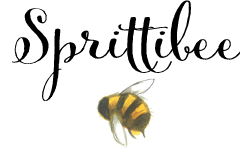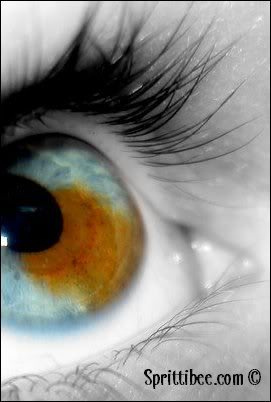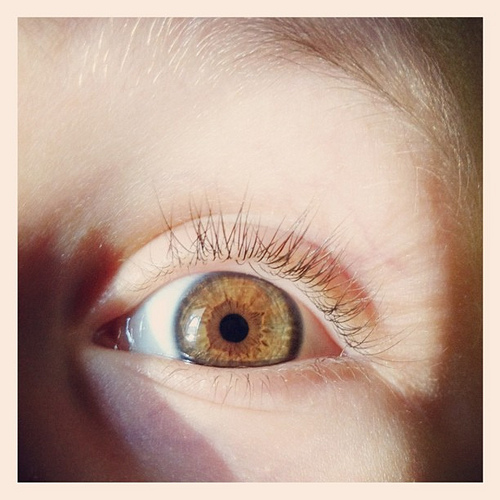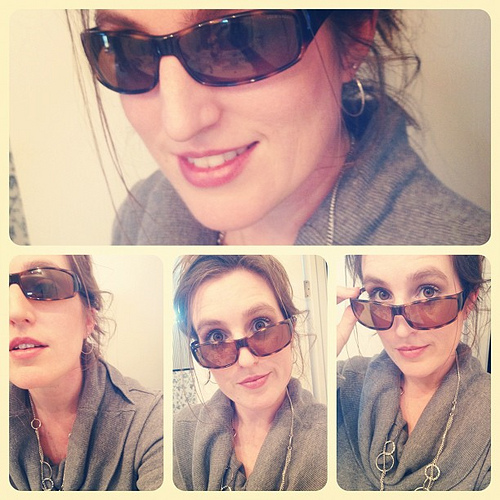When my daughter was born, she had a birthmark in her eye. We used to joke that she looked mostly like her daddy (he’s got dirty blond hair and sea blue eyes just like her), but that I hung on to get just a little spot of her – the brown spot in her eye. Her birthmark is exactly the color of my eyes – an orange-brown. We took her to see an eye doctor after the pediatrician told us that it needed to be checked out, and found that she has an increased risk of eye cancer because of this beautiful spot.
Did you know that blue, green, and grey eyed people are more likely to have UV eye damage (and eye-related melanoma) than dark eyed people? There was a LOT of things I didn’t know about eye health. I was so relieved that her birthmark, also called a “sectoral heterochoromia” wasn’t anything to be worried about. And yet, over time, we have really become lax about wearing our sunglasses as a family. Which is sad, because I don’t just have one child now with blue, green or grey eyes… I have THREE.
I mean, WHAT color eye would you call this??? Maybe another heterochromia? And of course, the tiny dude (who is 1 years old) has his daddy’s Caribbean blue peepers.
Recently, I was asked to participate in an eye health campaign by the Vision Council. Remembering my daughter’s doctor’s advice after all this time (she’s 13 now) made me feel like a flop of a parent (hello, I KNOW my kids should be wearing sunglasses). Scrolling back through years worth of flickr photos of my kids and I on field trips and outdoors, I felt convicted seeing hardly any pictures where we were all wearing sunglasses. It made me want to go buy a new pair of good polarized, UV protective glasses of each of us. Or at least find a pair (I know we have them around here somewhere…) and set them in the box by the entry-way so we remember to take them every time we leave the house as we pick up our keys to the car.
The Vision Council is a nonprofit trade association representing the manufacturers and suppliers of the optical industry. My mom used to be in the industry, too – she sold frames to optical shops for years, working for manufacturer lines. She was what I used to call “the middle man”. I always loved it because I had a ton of awesome shades to pick from in her huge frame kits – and most of them were name brands for wholesale prices.

The Vision Council also works is educating adults and children about vision health and eye safety. I love their website, The Bureau of Missing Sunglasses (BOMS)! They have a facebook and twitter account, too! So cute that they keep a running scroll of their MOST WANTED (twitter mentions of people who have lost or broken their sunglasses). I know I would fall in that category often – I seem to run through glasses and leave them everywhere I go.
This is where the info gets important:
One of the doctors on their board offered a group of bloggers on a teleconference call about eye health gave us these statistics.
I bet you are as “in the dark” as I was about these eye health facts – check this out…
– In a recent survey of 10,000 U.S. adults, 73 percent of parents wear sunglasses to protect their eyes from ultraviolet radiation, while only 58 percent have their children wear sunglasses. That means that nearly half of parents aren’t protecting their children’s eyes from harmful UV radiation.
– UVA and UVB rays are constantly penetrating the Earth’s surface, leaving unprotected eyes exposed to harmful radiation. Although it’s commonly misperceived that UV rays are only out during sunny days, they are actually present throughout the day – no matter the season or weather.
– Even a small amount of unprotected exposure is dangerous. UV exposure adds up over time and can lead to serious health problems as you and your children age. That’s why it’s increasingly important to have sunglasses handy at all times.
– Children receive three times the annual sun exposure of adults, and they have an immature lens, which makes them especially susceptible to UV-related damage. UV exposure at any age can cause both short and long term vision problems – many of which can’t be reversed.
– So how can you keep kids safe without cutting down their outdoor time? Buy a pair of UV-protective sunglasses from a reputable retailer, and use them!
Here’s what they have to say about finding a good pair of sunglasses:
– The Vision Council suggests taking the following “crucial considerations” into account when choosing a pair of sunglasses: 1) Comfort (so you’ll actually wear them), 2) Reliability (buy from a reputable retailer – not street vendors or popular auction sites), 3) Active Lifestyle (consider your daily activities in your choice of sunglasses), 4) Design and fit that works best for you/your children.
– To determine if your sunglasses are reliable, look for a little sticker or tag on the lens that shows compliance with criteria set by the American National Standards Institute (ANSI). The label “UV 380” covers all UVA and UVB rays.
– For the beach or pool friendly family, consider polarized lenses. They work exceptionally well at filtering out reflected glare from shiny surfaces like water and pavement. Polarized lenses also improve contrast and visibility so you don’t feel like you need to squint. (Hello – they also prevent wrinkles! No squinting = relaxed face!)
– For the sports players and enthusiasts, you should look into impact-resistant lenses. These lenses are designed to handle high-impact, like baseballs, lacrosse balls, Frisbees, or any other projectile. Most of these lenses are made from high performance materials like polycarbonate, polyurethane or Trivex.
– For parents always on the go, consider anti-reflective lenses that provide extra protection in difficult lighting situations. These can be especially helpful on the road and during sunrise and sunset.
– The Vision Council’s website www.missingsunglasses.com is also full of useful information about sunglasses, lenses, tints and frames.
Here was some of the advice they had for helping your little ones wear sunglasses (this is a challenge for us):
– While your child or children may love a pair of sunglasses at the store, wearing them consistently can be difficult.
– As parents, we always have to be creative. If your kids like stickers, you might try letting them put two to three stickers on glasses to give them some independence. I recommend limiting sticker use to the frames so that you don’t cover any lines of sight.
– For little ones, buy an inexpensive pair of sunglasses and outfit their favorite stuffed animals in them. When their favorite friends are being sunwise, they will be too.
– You should also try wearing your sunglasses every time you have the opportunity. Not only is it a healthy habit to get into – it will also reinforce this behavior in your children.
I’m going to work on being a better example by wearing my sunglasses and encouraging my kids to wear theirs. These in the photo above are my favorite pair, by the way… Polo Sport, polarized. I love the way the puffy clouds look when I’m looking through them on a sunny day.
{The future might be bright, but I’m going to try harder to remember to wear my shades.}

Subscribe to Sprittibee by Email
Disclaimer: This post was sponsored by the Vision Council. All the information and statistics can also be found on their website. I’m not a doctor, so please seek out an medical professional if you have questions regarding the optical health of your family.




I’m trying to be good about wearing sunglasses just for those reasons (plus it’s hard to avoid it in the Texas heat / sun). My son (only 18 months) use to be really good at wearing them, and now he just wants to throw them off (the same w/ hats).
I will keep trying!
-Tara
http://madmaxandfamily.blogspot.com
http://blog.chron.com/madabouttown/
I always agree that glasses are extremely important and as the mother of a very light haired, light skinned, light eyed kid…it’s a constant battle. I read and re-read your post and it reminds me of the need to protect our eyes. Thanks.
Yes, we just went and added Transition lenses to our newest glasses that we ordered for this school year. It cost me an extra 85$ a pop, but I think it will make them wear their sunglasses more often!
So is that second eye not a brown eye with a grey ring? Honestly eye color can change through out a persons life, mine change based on mood and health. Never to brown but a broad spectrum between med blue to grey to green. Generally my family calls me blue eyed
My middle child I knew would not stay blue, in fact I never called them blue even though others did, at one year she was hazel, a mix of all 4 colors, now at 7 firmly golden brown.